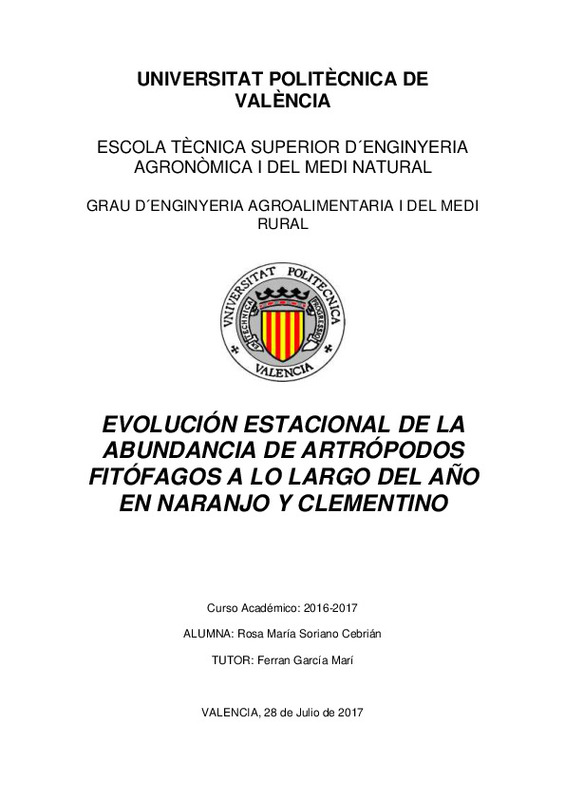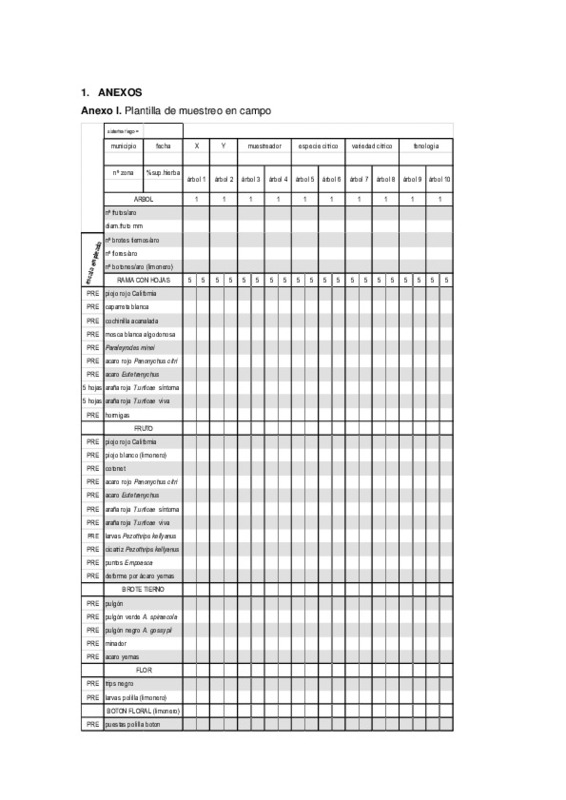|
Resumen:
|
[ES] Con el fin de apoyar la toma de decisiones en relación a la gestión de plagas se
determinaron la incidencia relativa de las plagas más importantes presentes en el cultivo
de cítricos, así como la evolución estacional ...[+]
[ES] Con el fin de apoyar la toma de decisiones en relación a la gestión de plagas se
determinaron la incidencia relativa de las plagas más importantes presentes en el cultivo
de cítricos, así como la evolución estacional de los mismos, siempre comparando entre
naranjo y clementino, se realizó un seguimiento de las poblaciones de fitófagos y de
enemigos naturales en la Ribera Alta y Costera (Valencia, España). Para ello se
observaron diversos tipos de órganos (flores, frutos, brotes tiernos, ramas con hojas) en
10 árboles por parcela, en 20 parcelas semanales, entre abril y octubre de 2016. De las
20 parcelas muestreadas, aproximadamente 10 eran naranjo y 10 eran clementino todas
elegidas al azar. También se analizó la evolución estacional de la proporción de estadios
de desarrollo de Aonidiella aurantii a fin de determinar los momentos máximos de formas
sensibles. Para ello se seleccionaron dos parcelas fijas, una por comarca, con
abundante presencia de piojo rojo de california para poder así, semanalmente, coger
muestras de ramas con piojo rojo de california y hacer el conteo de estadios. En estas
mismas parcelas, para el seguimiento de enemigos naturales, se colocaron
semanalmente dos trampas pegajosas con feromonas que fueron analizadas en
laboratorio.
A lo largo del estudio se ha observado que: el piojo rojo de California Aonidiella aurantii
incrementa progresivamente su presencia en frutos en verano alcanzando en
septiembre entre 1 y 2% de frutos infestados. Muestra en la zona los dos máximos de
inmaduros habituales, uno en la primera quincena de junio y otro en la segunda
quincena de julio. Los brotes tiernos son infestados por pulgones en primavera,
alcanzando el 50% de brotes infestados. Posteriormente el minador infesta los brotes
tiernos en verano alcanzando el 8% de brotes infestados. Ambos fitófagos muestran
comportamientos muy similares en naranjo y clementino. El trip Pezothrips kellyanus
ataca y causa daños sobre todo en frutos de naranjo, mientras que la araña roja
Tetranychus urticae aparece solo en clementino. Se ha identificado la presencia de otras
plagas de menor abundancia y de forma similar en naranjo y clementino: moscas
blancas (Paraleyrodes minei y Aleurothixus floccosus), Icerya purchasi, Ceroplastes
sinensis y Aceria sheldoni. Los parasitoides más abundantes han sido Lamennaisia,
Scelionidae y Aphelinus. Este último parasita pulgones. Los depredadores más
comunes encontrados en las trampas han sido Rodolia cardinalis, Scymnus spp.,
Stethorus punctillum y Propylea quatuorderimpunctata.
[-]
[EN] To support the decision-making in relation to pest management was determined the
relative incidence of the most important pests present in the cultivation of citrus fruits, as
well as the seasonal evolution of the ...[+]
[EN] To support the decision-making in relation to pest management was determined the
relative incidence of the most important pests present in the cultivation of citrus fruits, as
well as the seasonal evolution of the same, always comparing between orange and
clementine, there was a monitoring of the populations of phytophagous and natural
enemies in the Ribera Alta and Costera (Valencia, Spain). For this purpose, various
types of organs (flowers, fruits, shoots, branches with leaves) were observed in 10 trees
per plot, in 20 plots per week, between April and October 2016. Of the 20 plots sampled,
approximately 10 orange and 10 were clementine all chosen randomly. It´s also analyzed
the seasonal evolution of the proportion of stages of development of the Aonidiella
aurantii to determine the maximum time sensitive forms. For this purpose, two fixed plots
were selected, one per region, with abundant presence of Aonidiella aurantii to de able,
weekly, to take samples of branches with Aonidiella aurantii and do the count of stages.
In these same plots, for the monitoring of natural enemies, were placed weekly two sticky
traps with pheromones that were analyzed in the laboratory.
Throughout the study, it was observed that: Aonidiella aurantii progressively increased
its presence in fruit in summer reaching in September between 1 and 2 per cent of fruits
infested. Displays in the area the two peaks of immature, one in the first half of June and
another in the second half of July. The buds are infested by aphids in spring, reaching
50% of outbreaks infested. Then the miner infests the tender buds in summer reaching
the 8% of outbreaks infested. Both phytophagous show very similar behaviors in orange
and clementine. The trip Pezothrips kellyanus attacks and cause damage especially in
fruits of orange, while Tetranychus urticae appears only in clementine. It has identified
the presence of other pests of lower abundance and similarly in orange and clementine:
whiteflies (Paraleyrodes minei and Aleurothixus floccosus), Icerya purchasi, Ceroplastes
sinensis and Aceria sheldoni. The most abundant parasitoids have been Lamennaisia,
Scelionidae and Aphidius. The latter interference aphids. The most common predators
found in the traps have been Rodolia cardinalis, Scymnus spp., Stethorus punctillum and
Propylea quatuorderimpunctata.
[-]
|








